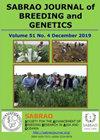COMBINING ABILITY FOR YIELD, OIL CONTENT, AND PHYSIO-BIOCHEMICAL CHARACTERS OF CANOLA (BRASSICA NAPUS L.) UNDER SALT STRESS CONDITIONS
IF 1.7
Q3 PLANT SCIENCES
引用次数: 0
Abstract
Creating a half-diallel cross succeeded among seven diverse canola genotypes. The obtained 21 F1 hybrids with their seven parents underwent three salinity stress levels exposure—3.91 dsm1 (Normal), 6.24 dsm-1 (S1), and 7.81 dsm-1 (S2) —during the 2020/2021 growing seasons. Salinity treatments significantly reduced days to 50% flowering, plant height, number of primary branches, pods/plant, 1000-seed weight, seed yield/plant, seed oil content, relative water content, calcium, potassium, and the ratio between K+ and Na+ compared with a normal condition. Proline content, osmotic pressure, and Na+ were considerably higher under salinity stress conditions. Highly significant differences showed among the parents and hybrids for all traits across the tested environments. General (GCA) and specific (SCA) combining ability effects were highly significant for all attributes. The parental genotypes Serw4 and Pactol resulted as good general combiners for increased seed oil content (SOC), seed yield/plant (SYPP), and some of its components in research environments. The hybrid combinations H2/S × Serw4 and Serw4 × Serw6 were good specific combiners for days to first flower (DTF), number of primary branches (NPB), number of pods per plant (NP), a thousand seed weight (TSW), seed yield per plant (SYPP), seed oil content (SOC), proline content (ProC), Ca++, and K+/Na+. The SDS-PAGE analysis of seed proteins indicated high levels of genetic variability and revealed some vital biochemical markers for salt tolerance.油菜产量、含油量及生理生化性状的配合力在盐胁迫条件下
在七种不同的油菜基因型之间成功地建立了半双列杂交。获得的21个F1杂交种及其7个亲本在2020/2021生长季节经历了三种盐度胁迫水平——3.91 dsm1(正常)、6.24 dsm-1(S1)和7.81 dsm-1(S2)。与正常条件相比,盐度处理显著降低了50%的开花天数、株高、一级分枝数量、荚/株、1000粒种子重量、种子产量/株、种子含油量、相对含水量、钙、钾以及K+和Na+之间的比例。脯氨酸含量、渗透压和Na+在盐度胁迫条件下显著较高。在测试环境中,亲本和杂交种在所有性状上都表现出高度显著的差异。一般配合力(GCA)和特异配合力(SCA)效应对各性状均具有显著性。亲本基因型Serw4和Pactol在研究环境中是提高种子含油量(SOC)、种子产量/植株(SYPP)及其某些成分的良好通用组合。杂交组合H2/S×Serw4和Serw4×Serw6对初花天数(DTF)、一级分枝数(NPB)、单株荚数(NP)、千粒重(TSW)、单株种子产量(SYPP)、含油量(SOC)、脯氨酸含量(ProC)、Ca++和K+/Na+具有良好的特异性。种子蛋白的SDS-PAGE分析表明,种子蛋白具有高度的遗传变异性,并揭示了一些重要的耐盐生化标记。
本文章由计算机程序翻译,如有差异,请以英文原文为准。
求助全文
约1分钟内获得全文
求助全文
来源期刊

Sabrao Journal of Breeding and Genetics
农林科学-奶制品与动物科学
CiteScore
1.90
自引率
50.00%
发文量
63
期刊介绍:
The SABRAO Journal of Breeding and Genetics is an international journal of plant breeding and genetics research and was first published in 1969. It is the official publication of the Society for the Advancement of Breeding Research in Asia and Oceania (SABRAO).
Its objectives are to: promote the international exchange of research information on plant breeding and genetics, by describing new research findings, or ideas of a basic or practical nature; and be a medium for the exchange of ideas and news regarding members of the Society.
The Journal gives priority to articles that are of direct relevance to plant breeders and with emphasis on the Asian region. Invited for publication are research articles, short communications, methods, reviews, commentaries, and opinion articles. Scientific contributions are refereed and edited to international standards.
The journal publishes articles for SABRAO members mainly. The Journal preferred strongly that at least one author should be a current member of the Society. Non-members may also publish in the journal.
 求助内容:
求助内容: 应助结果提醒方式:
应助结果提醒方式:


